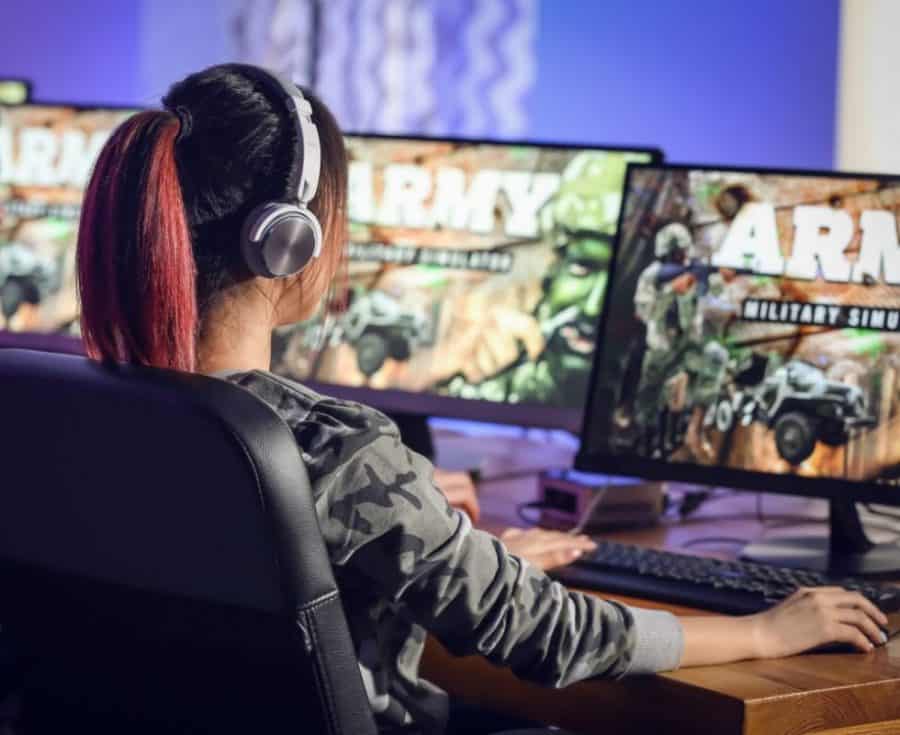
You're a gamer, and you want to be able to game the best. That means being on top of your game, with your eyesight in tip-top shape. But how far should you sit from your gaming monitor? The answer is not so simple!
There's no perfect rule to the question "how far should I be from my gaming monitor?" because everyone has different needs. But the are important factors that will affect this decision, which we will discuss below.
Is sitting close to a monitor bad?
The common misconception is that sitting closer to a monitor will cause eye strain. However, if you're at the correct distance, it should not give your eyes too much trouble.
The best way to find out whether or not this is true for you personally? See how close you can go without having to squint. But note, when sitting too close to a screen, one common symptom is that our eyes feel tired all the time
If you're having trouble seeing the difference between light and dark colors, or light text on a darker background, it might be time to switch up your monitor's settings!
How far away should you sit from your monitor?
You should sit at least an arms-length away from your monitor. You need the monitor at least 20 inches from your eyes—about an arm's length away. If you're using a larger screen, add more viewing distance between yourself and the screen.
Also, make sure to keep glare down by adjusting the screen position.
Twelve things to consider for optimal distance from your monitor
1. Sit far enough away from your monitor so that you can see the entire screen
You should be able to see the entire screen without having to move your head from left to right. This will reduce eye strain and make it easier for you when adjusting settings or reading text on the monitor.
Sit far enough away so that you can read everything clearly, with no neck craning required! But don't sit too close either: if you're often zoomed in looking at details of an image, moving around a lot, or have poor eyesight such as nearsightedness (myopia), then sitting closer may help lessen some eyestrain symptoms. Experimentation is key here—sit where feels most comfortable for you! The optimal distance will vary depending on how old your eyes are, whether you wear glasses, and what you're looking at.
Sit far enough away so that you can read everything clearly, with no neck craning required! But don't sit too close either: if you're often zoomed in looking at details of an image, moving around a lot, or have poor eyesight such as nearsightedness (myopia), then sitting closer may help lessen some eyestrain symptoms. Experimentation is key here—sit where feels most comfortable for you! The optimal distance will vary depending on how old your eyes are, whether you wear glasses, and what you're looking at.
2. Distance between your eyes and the monitor
The second factor that should be taken into consideration when deciding how far away from the monitor you should sit is the distance between your eyes and the screen, in other words, ergonomics.
When sitting back farther so that you can see everything on the display without moving your head too much then it may help with reducing eyestrain which could lead to problems such as headaches or eye-strain due to long periods of time staring at a computer screen. However if doing this causes an uncomfortable viewing angle for playing games where players use peripheral vision then they will need to adjust their position by either getting closer to or further away from their monitors depending on what game they
3. Where do you look most frequently on a monitor
Another factor to consider for how far away from your monitor you should sit is where on the monitor will you look most frequently?
You want to take into consideration not only what type of game you play but also what functions would require close up monitoring such as editing video footage.
If during gameplay, players mainly use peripheral vision then sitting back farther may work best.
4. Adjust height and tilt for comfort
When you're seated, the top of your monitor should be eye level with your eyes. Laptops are different: they can have screens positioned to make them more comfortable to use.
The height of your eyes should be approximately 2-3 inches from the top of the screen, or about halfway up on a laptop.
That's why it is important not only that the screen height and tilt are adjusted but also that laptops are propped up on a desk or stand so the glare minimizes reflections from overhead lighting. The angle from your eyes to your monitor while gaming should be about 90 degrees.
Some gamers find it more comfortable to wear glasses while gaming because the lenses change the focus of their eyes and help them see better: this is why some monitors have anti-glare screens or a built in glare guard; if your screen has these features, make sure they are active when you're playing so that your eyes stay healthy.
5. Try not to sit in front of any windows or other light sources
Sitting where your monitor catches a lot of light from windows or lightbulbs is a bad idea, as the light will make it more difficult to see your screen and you'll have less control over how bright or dim it is.
Position yourself at a 90 degree angle to avoid glare (or use an anti-glare filter).
Most monitors nowadays come with an anti-glare filter which can help eliminate glare from light.
6. The size of the monitor
Whether you have a large or small screen, the appropriate distance for your monitor will depend on the size of the screen, and where you are playing from.
The size of your screen will also affect what kind of viewing distance and resolution works best for you. We recommend a minimum 16 x 12 inches, or 17-24 inches if multiple people use the same computer (e.g., in an office). Larger screens will also allow for a higher resolution.
The size of the monitor, whether you are sitting close to it or far away from it, can have different effects on your eyesight depending on what distance is most comfortable for you. If you're not sure how big your screen should be or where to sit in relation to your screen, talk with an eye care professional about what would work best for getting rid of eyestrain and headaches.
If you're using a 24-inch monitor to play at a desk or table, it is recommended that your eyes be 22 inches away from the viewing surface; this measure can vary depending on how far back in space you're sitting from the screen.
7. Blink Rate
Blink rate is another factor in how you can keep your eyes comfortable while playing, and many eye doctors recommend 20 blinks per minute to avoid dry or tired eyes after gaming for a long time. Increasing blink rates will also help maintain healthy tear production levels on your corneas- preserving this layer of mucous membrane that protects the surface of the eye against disease and infection.
Many people use their monitors as an extended desktop with multiple work areas/windows open at once; if possible, position yourself so you are facing either north or south rather than east or west when using a dual monitor setup. Positioning your computer desk away from windows (especially those with bright sunlight) may help.
8. Your viewing distance from the screen
The distance between your eyes and monitor can vary depending on what type of work you're doing with them (e.g., editing photos vs playing games), but most monitors are adjustable so you can change the height and distance.
Sitting too far away from a monitor (for instance, if you're using an old CRT) will make it difficult to see what's on your screen. The same problem applies for sitting right next to a monitor - be careful not to strain your eye muscles by squinting at pixels.
9. What type of computer desk setup you use (monitor on stand vs. directly on desk)
The size of your desk and chair can also affect the distance required.
If you are a taller person, your monitor should be at eye level so that you don't have to bend down and strain. If not, invest in a stand or arm desk attachment for added comfort.
10. How much space you have to work with in front of your computer
One of the most basic considerations when choosing a gaming monitor is sizing. When it comes to screen size, bigger isn't always better! In fact, this might not be feasible if you have limited desk space or are using your laptop as a desktop replacement.
11. What type of games you play
If you are going to use your monitor for work or school presentations, then it is best to have a large screen that can display all of the information at once. For gamers however, especially competitive ones on consoles such as Xbox and Playstation, a smaller size might be better because they need quick access to menus in-game without having them take up too much space.
Another thing to consider is the resolution and refresh rate of your gaming monitor as these will have a huge effect on how pleasant or unpleasant it will be when playing video games.
For example, if someone has bad eyesight, then they should try to get an 1080p (or higher) monitor with at least 144Hz screen refresh rate as this would significantly reduce eyestrain while gaming.
12. Monitor resolution
Your monitors resolution can also change how far you should be sitting from it.
The monitor resolution should have a similar size to the distance you are sitting away from your screen in order for everything on the screen to look sharp and clear.
For gamers, this means that if they're playing 1080p games, then their computer desk setup needs to account for that gaming requirement by including a 1080p monitor or larger (though not always necessary).
For example: If you sit 15 inches away from your 24-inch monitor with 1920 x 1200 resolution, but want to play 1080p content at 22 inches instead of 24 inches - find a 27 inch 2560 x 1440 resolution monitor.
This will ensure there aren't any translation issues when displaying fullscreen games while also maintaining optimal comfort levels. Similarly on retina screens you generally want to sit far enough away that you can't see individual pixels.
Conclusion
There are many factors that come into play when determining how far to sit from your gaming monitor. It's important to be aware of these considerations so that you can enjoy a comfortable and immersive experience while still playing at the capacity of your device.
Hopefully, we've highlighted some of these so that you can figure out what distance works best for you.
Happy gaming 🙂
